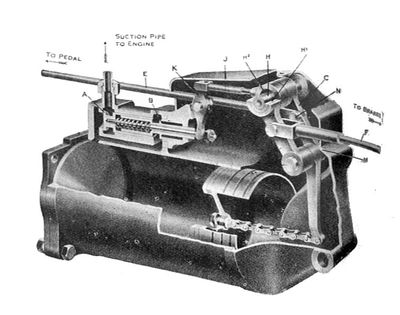What Does A Brake Servo Actually Do?

There are many bits on cars we know exist, but don’t really give much thought about their importance. We’d be willing to bet the brake servo (or brake booster, to those of you in the US) registers high on that list for most of us.
In short, the servo is an important step between you putting your foot on the brakes and them actually being applied, and it’s the thing that means you don’t have to put too much effort into stopping a car.
How does a brake servo work?

To explain the servo, we have to go back to basics for a moment. Pressing your middle pedal forces a pushrod into the sealed master cylinder, which is filled with oil.
From there, a pair of pistons displace that oil which then travels down the brake lines and to the callipers. Hey presto, the callipers are actuated, pushed against the disc and then friction does its thing to slow you down. That obviously requires some physical effort, and without a servo, that could get pretty tiring.

The most common type is a vacuum servo. The vacuum is created inside the main body of the servo via a pipe running to the engine’s air intake (it’s why your pedal feels different with the engine turned off), although on diesels, this is usually created by an additional hydraulic pump.
Once you press the pedal, a rod is pushed into a housing which contains two springs and an air filter. That sees air flood one side of the servo body, itself separated into two sections via a diaphragm. A vacuum remains in the side connected to the air intake or hydraulic pump, creating a pressure difference between the two chambers.

That pressure difference results in the diaphragm being pulled towards the master cylinder, forcing the pushrod into it with the help of a spring. Basically, it’s giving you a helping hand when applying your brakes – otherwise, it’d rely entirely on your right leg. Not great if you’re the kind of person who regularly skips leg day.
Do all cars have brake servos?

Although we can’t say with exact certainty given how many are on sale across the world today, you could probably safely put your house on every modern road car having a brake servo fitted. The tech first came around in the late 1920s and quickly became commonplace.
Race cars are usually the exception to the rule, often in a bid to save a little bit of weight. See also the McLaren F1.
Can I upgrade it?
Technically yes, you can upgrade a brake servo but it’s not a common modification. Largely as it doesn’t physically improve the performance of a braking system, but rather reduces the effort required from the driver to stop a car.
It’d be better to look at upgrading the discs, pads or brake lines if you’re simply looking for more stopping power.














Comments
Inb4 brake puns
Please Stop any brake puns
I laughed at this comment so hard my phone fell and broke
I red evert sentence twice so as not to mss any brake puns
I don’t see the need to put a brake on the puns yet…
The brake system contains no oil, it’s a fluid. Brake fluid is more closely related to anti freeze than oil and it has water absorbing capabilites as in that it’s hygroscopic. A common misconception, even with older mechanics.
Or you do left-foot-braking